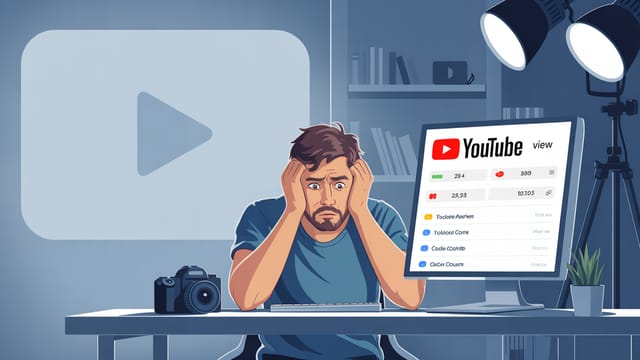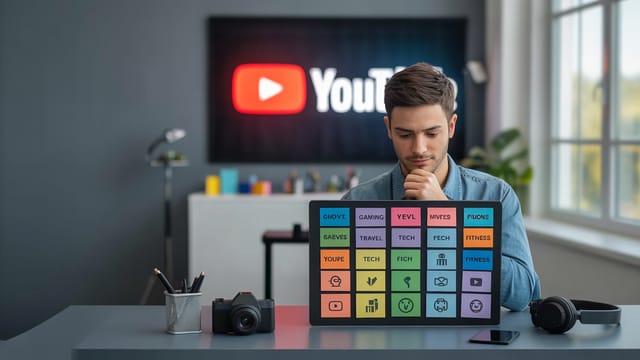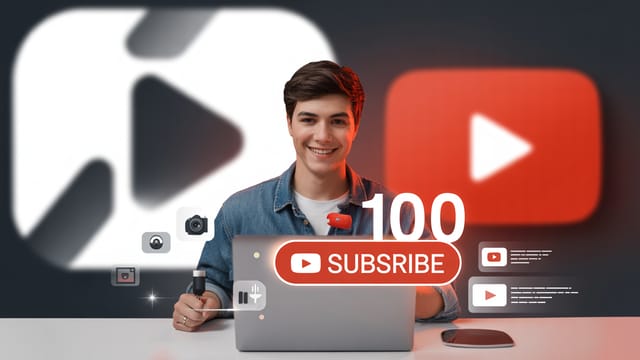
Ready to get your next 10,000 subscribers?
Join thousands of creators who use Subscribr to create faster, better YouTube videos.
How to Research YouTube Video Ideas People Actually Search For
Feeling stuck on what video to make next? Staring at a blank script, wondering what your audience actually wants to watch? You're not alone. 'Creator's block' and uncertainty about audience preferences are massive pain points for many intermediate creators. You've built a channel, maybe gained some traction, but consistently finding fresh, high-demand ideas feels like guesswork.
Stop guessing and start researching. The most successful YouTube channels aren't just lucky; they have a systematic approach to generating and validating video ideas. They build their content strategy around what their target audience is actively searching for, ensuring their videos have built-in demand from day one. This isn't just about chasing trends; it's about understanding search intent and creating content that provides real value to viewers looking for specific information or solutions.
In this guide, we'll explore practical, data-driven methods to uncover video ideas that resonate with your audience and boost your channel's discoverability.
Why Search Intent Trumps Simple Keywords on YouTube
Years ago, YouTube SEO was often boiled down to keyword stuffing titles and descriptions. The algorithm was simpler. Today, YouTube is far more sophisticated. While keywords still play a role, the algorithm prioritizes viewer satisfaction and search intent.
Think about it: if someone searches "how to change a tire," they have a clear intent – they need a step-by-step guide. A video that simply mentions "changing a tire" but is actually a vlog about road trips won't satisfy that intent. YouTube's algorithm is designed to identify videos that best fulfill the viewer's need, leading to higher watch time and engagement, which signals quality content and boosts rankings.
Modern YouTube strategy emphasizes:
- Outlier Theory: Analyzing which of your videos (or others in your niche) perform significantly better than average (high outlier scores) to identify successful formats or topics.
- Idea Transfer: Taking successful concepts or formats from one niche and adapting them for your own.
- Audience Engagement & Retention: Focusing on keeping viewers watching and interacting, as this is a primary signal to YouTube that your content is valuable.
- Content Quality & Viewer Satisfaction: Ultimately, the best "SEO" is making videos people love and find helpful.
Researching video ideas that people actually search for is the crucial first step in this modern approach. It ensures you're building content on a foundation of existing audience interest, making it easier to achieve those high engagement metrics and outlier scores.
Method 1: Using YouTube's Own Search Bar (It's Free!)
One of the most powerful, and often overlooked, tools for finding searchable video ideas is right there on YouTube itself: the search bar. YouTube's autocomplete suggestions are based on real search queries from millions of users.
Here's how to leverage it:
Start Broad, Then Refine
Begin by typing a general topic related to your niche into the search bar. For example, if you have a cooking channel, you might type "how to cook chicken."
As you type, YouTube will populate a dropdown list of popular search queries. These are phrases people are actively searching for. Pay attention to the order – the suggestions at the top are generally the most popular. You'll see specific questions or problems appear, like "how to cook chicken breast in oven" or "how to cook chicken thighs."
Explore Specific Angles
Refine your initial search by adding more specific terms. If your channel focuses on healthy eating, you might search "healthy chicken recipes." Again, look at the autocomplete suggestions for more specific long-tail keywords like "healthy chicken and broccoli recipe" or "healthy chicken meal prep."
This process helps you move from a broad topic to specific, high-intent ideas that viewers are looking for solutions to.
The Underscore Trick
Here’s a lesser-known trick: type an underscore _ followed by a space before your topic keyword. For instance, _ cooking. This reveals popular terms that precede your keyword, uncovering different search intents or categories. You might see suggestions like "easy cooking," "beginner cooking," or "healthy cooking."
Alphabetical Exploration
After typing your keyword (or using the underscore trick), add a space and then type letters of the alphabet (a, b, c, etc.). This will show you autocomplete suggestions starting with those letters. For example, typing "how to cook chicken a" might suggest "how to cook chicken alfredo," while "how to cook chicken b" might suggest "how to cook chicken breast." This method helps you explore a wide range of specific queries systematically.
By combining these techniques, you can generate a long list of potential video ideas directly from what your target audience is searching for right now.
Method 2: Diving Deeper with Data Tools
While the YouTube search bar is fantastic for uncovering ideas, dedicated tools can provide more in-depth data to help you validate those ideas and understand the competitive landscape.
Using YouTube Studio and Analytics
Your own YouTube Studio is a goldmine of information. The "Research" tab in Analytics (formerly "Search terms") shows you what people are searching for that leads them to your channel, as well as searches related to topics your audience watches. This is invaluable for understanding the specific language your audience uses and identifying content gaps you can fill.
Analyze your existing videos' performance in YouTube Analytics. Look at metrics like average view duration and click-through rate (CTR). Which topics or formats performed best? Identifying your own "outlier" videos can point you towards successful idea clusters.
Leveraging Subscribr for Enhanced Research
For a more systematic and powerful approach to data-driven idea research, tools like Subscribr offer integrated capabilities designed specifically for YouTube creators.
Subscribr's Research Assistant allows you to import and analyze content from various sources, which is crucial when researching a topic. You can import web pages, analyze YouTube video transcripts directly, or even upload documents. This centralizes your research materials and makes it easy to extract key information and insights relevant to your potential video ideas.
The AI Chat feature within Subscribr is also incredibly useful during the ideation phase. You can use it to brainstorm topics based on your niche, refine ideas generated from your search bar research, and even turn those brainstorming conversations directly into structured video outlines using the Chat-to-Script conversion. Because the AI chat is context-aware within the Subscribr platform, it understands your channel, audience, and existing content, leading to more relevant and personalized suggestions without you needing to constantly provide background information.
Subscribr's Channel and Video Intelligence features provide deeper insights into what's working in your niche and beyond. Instead of just seeing autocomplete suggestions, you can analyze actual channels and videos. For instance, using Subscribr's tools, you could search for "how-to tutorials" channels with over 10,000 subscribers, like we did in our research. This returned channels such as @quickasstutorials (228K subscribers) and @wpbeginner (1.02M subscribers), which demonstrate success in the tutorial format. Analyzing channels like these within Subscribr can reveal common topics, video structures, and thumbnail styles that resonate with audiences in the how-to space.
Similarly, searching for "beginner guide" videos with over 50,000 views, as we did, surfaces high-performing examples like "The ULTIMATE Year 1 Beginner Guide | Tips & Tricks" (over 407K views) and "Beginner's Guide to Procreate" (over 930K views). Subscribr's Video Intelligence can break down the structure and elements of these successful videos, helping you understand why they performed well and how you might adapt similar approaches for your own beginner-focused content. This data-driven competitive analysis, available through Subscribr's Intel features, is essential for identifying proven content formulas and finding opportunities.
Analyzing the Competition (Ethically)
Researching successful channels and videos in your niche isn't about copying; it's about understanding what the audience in that space responds to. Use tools to analyze:
- Top-performing videos: What topics, formats, and angles consistently get high views and engagement? Look beyond just the view count at metrics like outlier scores (available in tools like Subscribr) which indicate how well a video performed relative to that channel's average.
- Channel content strategy: What types of videos does a successful channel in your niche primarily create? How often do they upload? What seems to be their core value proposition?
- Audience engagement: What are viewers saying in the comments of popular videos? What questions are being asked that haven't been fully answered? This can reveal unmet needs and specific pain points you can address.
For example, analyzing channels like SimpliHow (797K subscribers) with its incredibly high VS Ratio of 6.56 suggests their simple, direct "how-to" videos are resonating strongly with viewers and driving disproportionately high views relative to their subscriber count. This indicates a strong alignment between their content and search intent.
Validating Your Ideas
Once you've generated a list of potential video ideas using the methods above, it's time to validate them. You want to ensure there's enough actual interest to justify creating the video.
- Check search volume: While YouTube doesn't publicly provide exact search volumes, the order of autocomplete suggestions gives you a good indication of relative popularity. Dedicated tools often pull data from Google searches (which overlap significantly with YouTube searches) to provide estimated search volume.
- Look at existing content: Search your potential video title on YouTube. How many videos already exist on this topic?
- If there are no videos, it might mean there's no demand, or you've found an untapped niche (rare, but possible).
- If there are some videos, look at their view counts. Are they getting decent views? This confirms there's existing interest.
- If there are many videos with high view counts, the topic is popular but competitive. Can you offer a unique angle, better quality, or a fresh perspective (e.g., "Beginner's Guide to X for Busy Parents" instead of just "Beginner's Guide to X")? The "beginner guide" video examples we found, like "The ULTIMATE Year 1 Beginner Guide" with over 400K views, show that even in potentially crowded topics, high-quality content targeting specific search intent can perform exceptionally well.
Using tools like Subscribr to analyze existing videos helps you understand the competitive landscape and identify how you can make your video stand out.
Turning Research into Action
Finding searchable ideas is just the beginning. The next step is transforming that research into a compelling video. This is where a structured content creation process becomes essential.
Subscribr's Script Building Pipeline is designed to take you from your validated idea through the entire content creation process. You can start with the research materials you gathered using the Research Assistant, define your video's specific angle and goals, generate optimized titles and hooks, build a detailed outline, and then write the full script section-by-section with AI assistance. This ensures your video stays focused on the search intent you identified and provides the value viewers are looking for.
Consistent Views = Consistent Revenue
Creating content based on searchable ideas has a direct impact on your channel's monetization potential. Videos that rank well in search results attract new viewers consistently, long after they're published. This evergreen discoverability leads to steady view generation, which is the foundation for ad revenue. By systematically researching and creating content that meets audience demand, you build a library of videos that continuously bring viewers to your channel, boosting your overall watch time and increasing your earning potential.
Conclusion
Overcoming 'creator's block' and the uncertainty of what your audience wants starts with smart research. By using YouTube's own search features and leveraging powerful tools like Subscribr, you can move from guessing to a data-driven strategy for finding video ideas. Focus on understanding search intent, analyzing what's working in your niche, and validating your ideas before you hit record. This systematic approach ensures you're creating content people are actively looking for, leading to increased discoverability, consistent views, and sustainable channel growth. Start researching today and build a content strategy that truly resonates with your audience.





